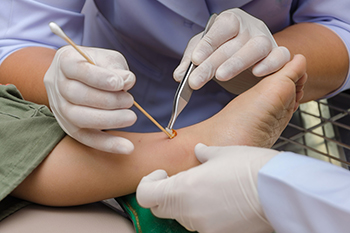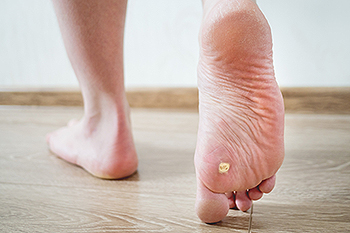Connect With Us
Blog
Items filtered by date: June 2023
What Is a Permanent Relief Solution for Ingrown Toenails?

An ingrown toenail is easily distinguishable and is defined as a toenail that grows into the skin instead of over it. An ingrown toenail often causes severe pain and discomfort, and it can become infected. This foot condition can happen for a variety of reasons. Common causes can include wearing shoes that are too tight and trimming the toenails incorrectly. There are some patients who have family members with ingrown toenails, which may increase the risk of developing this ailment. Temporary relief may be found when the affected nail is soaked in warm water. This can soften the skin enough so that a small piece of cotton can be used while gently pulling the nail away from the skin. Permanent relief is often found with medical attention. If you have developed an ingrown toenail, it is strongly suggested that you seek the counsel of a podiatrist who can provide appropriate treatment options, which may include minor surgery.
Ingrown toenails may initially present themselves as a minor discomfort, but they may progress into an infection in the skin without proper treatment. For more information about ingrown toenails, contact Dr. Harry I. Zirna of Lockport Foot Care, PLLC. Dr. Zirna can provide the care you need to keep you pain-free and on your feet.
Ingrown Toenails
Ingrown toenails are caused when the corner or side of a toenail grows into the soft flesh surrounding it. They often result in redness, swelling, pain, and in some cases, infection. This condition typically affects the big toe and may recur if it is not treated properly.
Causes
- Improper toenail trimming
- Genetics
- Improper shoe fitting
- Injury from pedicures or nail picking
- Abnormal gait
- Poor hygiene
You are more likely to develop an ingrown toenail if you are obese, have diabetes, arthritis, or have any fungal infection in your nails. Additionally, people who have foot or toe deformities are at a higher risk of developing an ingrown toenail.
Symptoms
Some symptoms of ingrown toenails are redness, swelling, and pain. In rare cases, there may be a yellowish drainage coming from the nail.
Treatment
Ignoring an ingrown toenail can have serious complications. Infections of the nail border can progress to a deeper soft-tissue infection, which can then turn into a bone infection. You should always speak with your podiatrist if you suspect you have an ingrown toenail, especially if you have diabetes or poor circulation.
If you have any questions, please feel free to contact our offices located in Lockport, NY . We offer the newest diagnostic and treatment technologies for all your foot care needs.
Why Live with Pain and Numbness in Your Feet?
Caring for Wounds on the Feet

Cuts and sores are common occurrences, and many happen to the feet. This is especially true during the summer months, when people are more likely to wear sandals and flip flops. In most cases, these minor wounds heal with a small amount of antiseptic gel and a bandage. However, if a wound does not heal properly, it may cause painful foot conditions. Signs that a wound needs professional care can include excessive bleeding, increasing pain, and pus or discharge. If a foot wound is becoming worse, a podiatrist can treat it with a series of actions. This can begin with flushing out the wound for any foreign particles that may be embedded, likely followed with a tetanus shot. With larger wounds, especially those bleeding profusely, stitches may be required, and pain medication will likely be prescribed. In certain cases, such as a diabetic ulcer, surgical treatment may be necessary. For more information about foot wound care, it is suggested that you make an appointment with a podiatrist as quickly as possible.
Wound care is an important part in dealing with diabetes. If you have diabetes and a foot wound or would like more information about wound care for diabetics, consult with Dr. Harry I. Zirna from Lockport Foot Care, PLLC. Dr. Zirna will assess your condition and provide you with quality foot and ankle treatment.
What Is Wound Care?
Wound care is the practice of taking proper care of a wound. This can range from the smallest to the largest of wounds. While everyone can benefit from proper wound care, it is much more important for diabetics. Diabetics often suffer from poor blood circulation which causes wounds to heal much slower than they would in a non-diabetic.
What Is the Importance of Wound Care?
While it may not seem apparent with small ulcers on the foot, for diabetics, any size ulcer can become infected. Diabetics often also suffer from neuropathy, or nerve loss. This means they might not even feel when they have an ulcer on their foot. If the wound becomes severely infected, amputation may be necessary. Therefore, it is of the upmost importance to properly care for any and all foot wounds.
How to Care for Wounds
The best way to care for foot wounds is to prevent them. For diabetics, this means daily inspections of the feet for any signs of abnormalities or ulcers. It is also recommended to see a podiatrist several times a year for a foot inspection. If you do have an ulcer, run the wound under water to clear dirt from the wound; then apply antibiotic ointment to the wound and cover with a bandage. Bandages should be changed daily and keeping pressure off the wound is smart. It is advised to see a podiatrist, who can keep an eye on it.
If you have any questions, please feel free to contact our offices located in Lockport, NY . We offer the newest diagnostic and treatment technologies for all your foot care needs.
Differences Between Walking and Running Shoes

It is beneficial for people who enjoy walking and running to learn about the differences between these two types of shoes. There are various forms of running, which can range from buying minimalist shoes that are designed for racing to cushioned shoes that are best for long-distance running. Most running shoes are made for different styles of running. These categories can include toe-strikers, midfoot strikers, and heel strikers. A person's foot structure and running type may lead to which type of shoe to choose. Research has shown people who enjoy taking a leisurely stroll may choose shoes that are designed for comfort instead of performance. Conversely, fitness walkers often prefer a flat, flexible, and lightweight shoe that does not cause the foot to slide. If you would like to have more information about the correct shoes to buy for the type of walking or running that is done, it is suggested that you consult with a podiatrist who can provide you with the knowledge you are seeking.
For more information about walking shoes versus running shoes, consult with Dr. Harry I. Zirna from Lockport Foot Care, PLLC. Dr. Zirna can measure your feet to determine what your needs are and help you find an appropriate pair of footwear.
Foot Health: The Differences between Walking & Running Shoes
There are great ways to stay in shape: running and walking are two great exercises to a healthy lifestyle. It is important to know that running shoes and walking shoes are not interchangeable. There is a key difference on how the feet hit the ground when someone is running or walking. This is why one should be aware that a shoe is designed differently for each activity.
You may be asking yourself what the real differences are between walking and running shoes and the answers may shock you.
Differences
Walking doesn’t involve as much stress or impact on the feet as running does. However, this doesn’t mean that you should be any less prepared. When you’re walking, you land on your heels and have your foot roll forward. This rolling motion requires additional support to the feet.
Flexibility – Walking shoes are designed to have soft, flexible soles. This allows the walker to push off easily with each step.
If you have any questions, please feel free to contact our offices located in Lockport, NY . We offer the newest diagnostic and treatment technologies for all your foot care needs.
Treatment Options for Plantar Warts

A plantar wart is a growth that develops on the sole of the foot. The wart is caused by coming into contact with the human papillomavirus, or HPV. Plantar warts are most commonly seen on the ball or heel of the foot. Because these two areas take the force of your weight, the wart may become hardened and look like a callus. It also may contain tiny black dots that are actually dried up or clotted capillaries. Plantar warts are contagious and should not be touched, if possible, because they can be spread to other body parts. Treatment options range from applying salicylic acid to remove the wart layer by layer to removing the wart at one time by surgery. Additional treatments of plantar warts include spraying with liquid nitrogen and laser therapy to burn off the wart. Each type of treatment brings with it certain painful or annoying side effects, and the methods take varied amounts of time to get the best result. For help with a plantar wart, it is suggested that you make an appointment with a podiatrist who can prescribe the treatment that will work best for you.
Plantar warts can be very uncomfortable. If you need your feet checked, contact Dr. Harry I. Zirna from Lockport Foot Care, PLLC. Dr. Zirna will assist you with all of your foot and ankle needs.
About Plantar Warts
Plantar warts are the result of HPV, or human papillomavirus, getting into open wounds on the feet. They are mostly found on the heels or balls of the feet.
While plantar warts are generally harmless, those experiencing excessive pain or those suffering from diabetes or a compromised immune system require immediate medical care. Plantar warts are easily diagnosed, usually through scraping off a bit of rough skin or by getting a biopsy.
Symptoms
- Lesions on the bottom of your feet, usually rough and grainy
- Hard or thick callused spots
- Wart seeds, which are small clotted blood vessels that look like little black spots
- Pain, discomfort, or tenderness of your feet when walking or standing
Treatment
- Freezing
- Electric tool removal
- Laser Treatment
- Topical Creams (prescription only)
- Over-the-counter medications
To help prevent developing plantar warts, avoid walking barefoot over abrasive surfaces that can cause cuts or wounds for HPV to get into. Avoiding direct contact with other warts, as well as not picking or rubbing existing warts, can help prevent the further spread of plantar warts. However, if you think you have developed plantar warts, speak to your podiatrist. He or she can diagnose the warts on your feet and recommend the appropriate treatment options.
If you have any questions please feel free to contact our offices located in Lockport, NY . We offer the newest diagnostic and treatment technologies for all your foot and ankle needs.
Blog Archives
- March 2024
- February 2024
- January 2024
- December 2023
- November 2023
- October 2023
- September 2023
- August 2023
- July 2023
- June 2023
- May 2023
- April 2023
- March 2023
- February 2023
- January 2023
- December 2022
- November 2022
- October 2022
- September 2022
- August 2022
- July 2022
- June 2022
- May 2022
- April 2022
- March 2022
- February 2022
- January 2022
- December 2021
- November 2021
- October 2021
- September 2021
- August 2021
- July 2021
- June 2021
- May 2021
- April 2021
- March 2021
- February 2021
- January 2021
- December 2020
- November 2020
- October 2020
- September 2020
- August 2020
- July 2020
- June 2020
- May 2020
- April 2020
- March 2020
- February 2020
- January 2020
- December 2019
- November 2019
- October 2019
- September 2019
- August 2019
- July 2019
- June 2019
- May 2019
- April 2019
- March 2019
- February 2019
- January 2019
- December 2018
- November 2018
- October 2018
- September 2018
- August 2018
- July 2018
- June 2018
- May 2018
- April 2018
- March 2018
- February 2018
- January 2018
- December 2017
- November 2017
- October 2017
- September 2017
- August 2017
- July 2017
- June 2017
- May 2017
- April 2017
- March 2017
- February 2017
- January 2017
- December 2016
- November 2016
- October 2016
- September 2016
- August 2016
- July 2016
- June 2016
- May 2016
- April 2016

